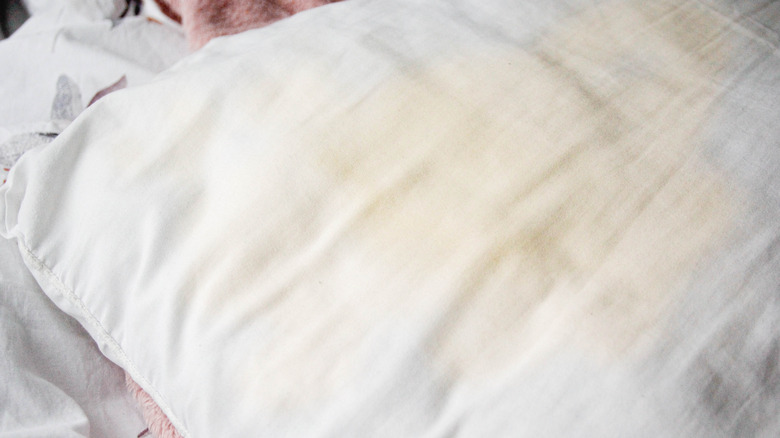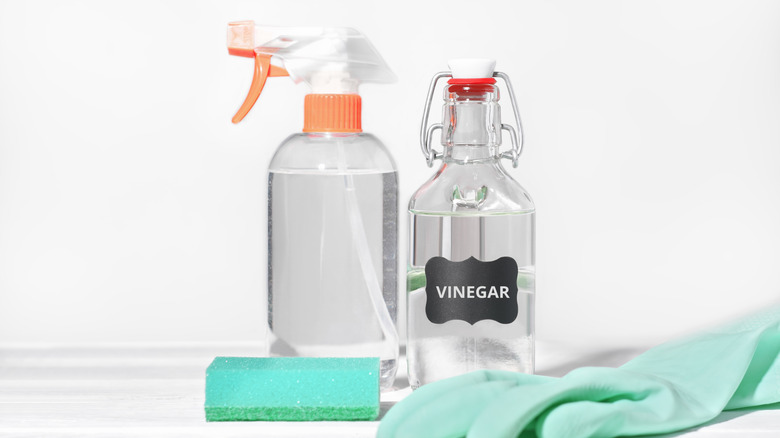The DIY Vinegar Solution That Breathes New Life Into Yellow-Stained Pillows
We may receive a commission on purchases made from links.
Some of the most commonly stained items in people's homes are pillows, and they can also be the most difficult things to clean. If you've run the same yellowed old pillow through the laundry six times and are almost ready to throw it in the garbage, you've also probably tried to look up a quick fix using home ingredients ... which means, finally, that you've already heard of the vinegar and baking soda "solution" all over the net. If not, the instructions are exactly what they sound like — a half-cup of vinegar here, a half-cup of baking soda there, and some soaking. Is this hack everything it's cracked up to be, though, or does it turn ... well, yellow, under scrutiny?
To find out, Hunker contacted laundry expert Zachary Pozniak, COO of Jeeves New York, to inquire about why bedding yellows and whether vinegar and baking soda really fix that problem. Pozniak explained that the reason our bedding colors easily is similar to what happens to your favorite fruits. "[It's] because our sweat and saliva oxidizes over time, turning it yellow," he said, "just like what happens to an apple or avocado when you leave it out." With that in mind, it's no wonder they can easily yellow after long enough.
And when it comes to the viral baking soda and vinegar hack, will these simple ingredients really do the job? Pozniak thinks not. Neither of them have whitening properties, he points out, and there's a deeper issue, as well. "Mixing baking soda and vinegar neutralizes the positive benefits of both," he says. "Do not do this!" Luckily, he also has some advice on what you should use instead, and his method of choice is another common household item — hydrogen peroxide.
Here's why vinegar and baking soda are not your best option for yellowed pillows
Baking soda — also known as sodium bicarbonate — is one of the most versatile products you can have in your home, as it has many cleaning properties such as deodorizing and gentle abrasion. White vinegar is also a commonly used cleaning agent, as it is both deodorizing and anti-microbial. As explained to us by Zachary Pozniak, COO of Jeeves New York, though, those two ingredients can't fix everything. Baking soda and vinegar make a great cleaning solution for certain purposes, but using them together in your laundry isn't going to get the results you want, no matter what online influencers might tell you.
Once they are combined, the chemical compounds in baking soda and vinegar react and produce sodium acetate, with water as a byproduct. While this is not harmful, it also doesn't provide any real cleaning assistance, so it's almost like giving your pillows a saltwater bath, rendering it pretty ineffective when it comes to stain-fighting. You also want to be careful when using vinegar in your laundry, in general, as the acidity can sometimes cause a breakdown of the fibers, or even damage your machine if you use it too frequently.
Hydrogen peroxide to the rescue of yellowed pillows everywhere
Now that we've ruled out the viral method, though, let's get back to the one that Zachary Pozniac, COO of Jeeves NY, offered to us in his exclusive interview with Hunker — especially given that he was so opposed to the vinegar and baking soda solution. To start, he suggested that one should clean as recommended, then follow it up with a hydrogen peroxide solution to get the most effective whitening. "To whiten, either spray 3% hydrogen peroxide on the pillow and air dry inside or soak in hot water and powdered oxygen bleach overnight, and then rinse and dry," said Pozniac. He added, "Repeat as needed."
Hydrogen peroxide is particularly useful when trying to remove protein and plant-based stains, which means it works for everything from blood to grass to wine to — in this case — sweat stains. Hydrogen peroxide has the benefit of being a natural disinfectant, much like vinegar. Similarly enough, it can be a bit hard on your fabrics, so you won't want to use it too frequently on delicate materials. Pillow shells, though, are made from more durable fabrics like a sturdy cotton or polyester blend, it is unlikely to do any damage especially when used sparingly.
Before you get started, you should also know that you don't want to mix hydrogen peroxide with anything such as vinegar, ammonia, chlorine or bleach as it could lead to the formation of some unpleasant — and potentially fatal — gasses. So proceed with caution, and follow Pozniak's advice to the letter.


